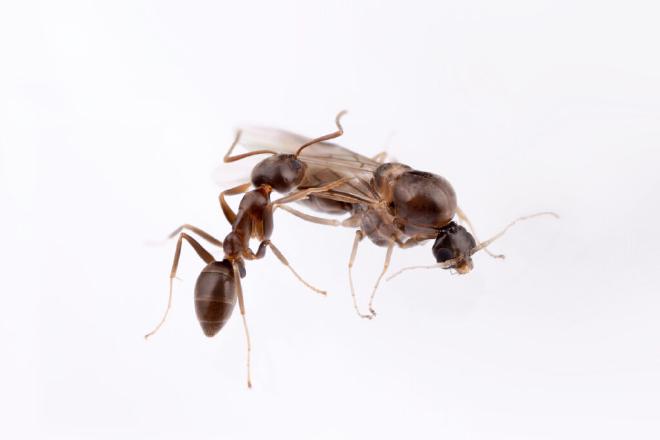

Researchers at Johannes Gutenberg University Mainz (JGU) and the University of Lausanne in Switzerland have been investigating the molecular mechanisms responsible for determining sex in ants. Although the vast majority of an ant colony consists of female workers, males are essential to the continuing survival of the species. **In order to uncover the mechanisms involved, the researchers decided to focus on diploid males, which occasionally occur in the Argentine ant. Sibling mating in this species can result in sterile males emerging from fertilized eggs – in cases where the alleles of the sex-determining DNA segment are identical. “This allowed us to compare the two sets of chromosomes present in females and diploid males, which differ from their haploid counterparts that possess only one set of chromosomes,” explained Dr. Qiaowei Pan, scientist at the Institute of Molecular Biology (IMB) in Mainz and at the University of Lausanne. It turned out that the two sets of chromosomes in the diploid males and females were identical along almost the whole genome – except in one particular region. “We were able to identify seven differing versions in a 5,000 base pair region of the genome. All the females had two different versions of this region while all the diploid males had the same alleles twice. Thus, this genomic location is fundamental to determining sex in this ant.” The corresponding research paper was published in Science Advances.
Researchers identify first noncoding gender-determining gene #
A research group at Heinrich Heine University Düsseldorf recently reported discovering a similar mechanism in honey bees. Unlike the females, the males here also have two identical alleles in the sex-determining DNA region. In the honey bee, this region is a protein-coding gene. This means that if there are two different versions of the gene, two proteins are generated that interact with each other. But the situation is different in ants. “To our surprise, we found that the sex-determining gene site in ants does not encode a protein. In other words, it does not contain the information required to make a protein. This is called a noncoding RNA gene,” said Dr. Qiaowei Pan. The genomic region does produce an RNA, but it does not carry the genetic information to produce a protein.
Another difference between females and diploid males also became apparent in terms of the amounts of this noncoding RNA gene produced at the sex-determining region. The level of RNA expression of this gene is higher in females who carry two versions of the sex-determining region than it is in diploid males with two identical copies of the region. In males, the expression of the noncoding gene remains low as they mature from larvae to pupae to adults, while it is consistently high across female development. To test how the expression of the gene influences the determination of sex, the researchers decided to switch off the expression of the noncoding RNA in female embryos – which resulted in a changeover to the male development pathway. “We were thus able to confirm that it is indeed the expression of this RNA that determines sex,” concluded Pan.
However, it is still puzzling to the researchers why carrying two different versions of the sex-determining region causes more RNA to be expressed. Hence, Dr. Qiaowei Pan and Dr. Hugo Darras, research group leader at the Institute of Organismic and Molecular Evolution at Mainz University, are currently collaborating with the team headed by Dr. Claudia Keller Valsecchi at the Institute of Molecular Biology (IMB) in Mainz to clarify the mechanisms underlying this previously unknown form of sex determination.
Citation #
Q. Pan, H. Darras, L. Keller, LncRNA gene ANTSR coordinates complementary sex determination in the Argentine ant, Science Advances 10: 22, 31 May 2024, DOI: 10.1126/sciadv.adp1532
Why is so important determining the sex of argentine ants? #
Determining the sex of Argentine ants is crucial for several reasons, particularly in understanding their biology and managing their populations. For example:
-
Reproductive Dynamics: Argentine ants have a haplodiploid sex determination system, where unfertilized eggs develop into haploid males, while fertilized eggs become diploid females. Understanding this system helps scientists grasp how reproduction occurs within colonies.
-
Population Control: By identifying the sex ratio within colonies, researchers can better understand population dynamics. This knowledge is essential for managing invasive populations, as imbalances can lead to overpopulation or collapse.
-
Behavioral Insights: Workers in Argentine ant colonies can discriminate between the sex, caste, and age of larvae. This ability influences how resources are allocated within the colony, affecting overall colony health and productivity.
-
Genetic Studies: Recent research has identified specific genes involved in sex determination, such as a noncoding gene that produces RNA but does not encode a protein. Understanding these genetic mechanisms can provide insights into evolutionary processes and help in the study of other species.
-
Ecological Impact: As an invasive species, Argentine ants can disrupt local ecosystems. Knowing their reproductive strategies and population structures can aid in developing effective control measures to mitigate their impact on native species.
Source: Argentine Ants an article written by Mark S. Hoddle, Ph.D. Biological Control Specialist and Principal Investigator on UC Riverside.

